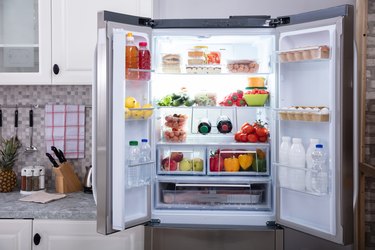
Mold happens. Despite your best effort to carefully box and store your dinner leftovers, it's common for plastic containers to make their way to the back of the refrigerator, where they take on a life of their own. It's important to know that while mold grows on the food inside these containers, it can also grow on the plastic itself. To keep your plasticware safe, you need to clean and sanitize mold-containing containers to make sure all of the mold spores are removed.
Have moldy food leftovers stashed in the back of your fridge? Here's what to do.
Video of the Day
Video of the Day
When to Throw Moldy Food Containers Away
Mold on plastic containers is not a death sentence. You can actually remove the mold pretty easily, and there is no need to throw away the container. There are a few exceptions, though.
You can generally save moldy plastic unless it has grooves and pits in it. Plastic cutting boards containing lots of scratches and plastic containers with rough patches caused by too much time in the microwave are best discarded when mold is present. You can remove the mold from the surfaces of these items, but there is no way to guarantee that you've removed all of the spores from any nooks, crannies, cuts, or pits in the plastic.
Things You'll Need
Paper towels
Dish soap
Large glass bowl
White vinegar (optional)
Baking soda (optional)
How to Clean Mold Out of Plastic Containers
1. Empty and Wash the Container
Always remember to protect yourself from mold. Most of the time, disposing of food that has just started to mold isn't a big deal. If you're sensitive to mold, however, or if you're cleaning out something really nasty, like the refrigerator in an abandoned rental unit, wear a mask.
- Don some rubber gloves to protect your hands.
- Use a paper towel to scrape the moldy food into the garbage. Wipe out as much food residue and mold as you can using more than one paper towel if necessary.
- Wash the plastic container with dish soap and a paper towel or a disposable rag. This prevents mold spores from collecting in the sponge or dish rag you normally use to wash your dishes.
2. Soak the Container
Soaking the container will disinfect it and kill any remaining mold spores. Bleach is an effective sanitizer for this task, but you can use vinegar instead if you prefer to take the natural route. Vinegar is effective, killing 82 percent of the known mold species. Vinegar will require a longer soak, however.
- Place your plastic container in a large glass bowl.
- Combine 1 cup of bleach and 1 gallon of water. Place the bleach solution in the bowl so that it fills the plastic container. Let the plastic soak in the bleach solution for 15 to 30 minutes.
- If you prefer, fill the plastic bowl with vinegar and allow it to soak for an hour. If desired, you can sprinkle some baking soda into the vinegar to add a little more cleaning power.
3. Rinse and Wash the Container
After soaking the container, you want to wash it out to remove the bleach or vinegar you soaked it in. If you used bleach, remember to put your rubber gloves back on first. Doing so will protect your hands from the bleach.
- Remove the plastic container from its soaking solution and rinse it thoroughly.
- Wash the container and the bowl you soaked it in with dish soap and warm water. Be thorough so you know you've removed any bleach residue. Vinegar residue clearly won't hurt you, but it could affect the taste of food, so you want to remove it thoroughly as well.